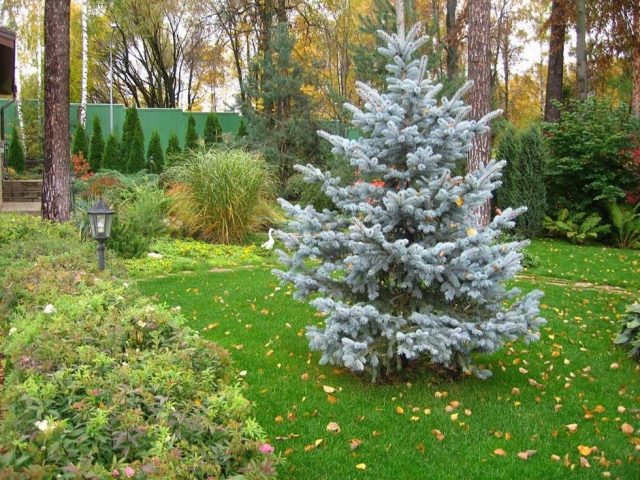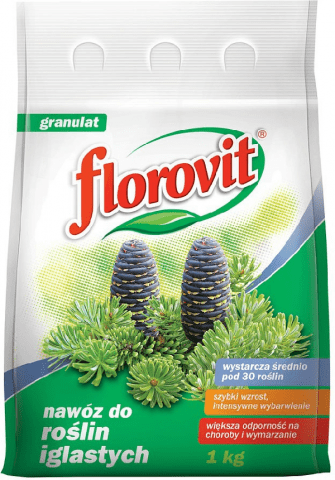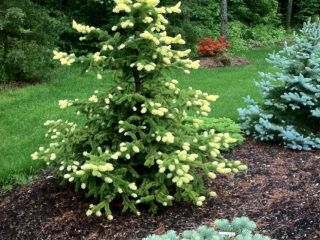Content
You need to feed the spruce despite the belief that this is not necessary, since the tree is evergreen and does not shed its leaves. There is some truth in this - a coniferous plant really requires less fertilizer. The tree will be better off with a deficiency of certain substances than with an excess of nutrition.
Signs of nutritional deficiency
Unlike deciduous plants, spruce and other conifers do not express nutritional deficiency with external signs so clearly. You can reliably find out about it by performing a soil analysis.
The lack of certain nutrients can be seen in the appearance of the spruce:
- dull reddish needles – lack of phosphorus or iron;
- yellowing of needles – magnesium deficiency;
- shedding of needles - there is not enough nitrogen, phosphorus or potassium.
A deficiency of necessary elements often appears in the first ten years, as the tree actively grows and develops. There are common signs of nutritional deficiency:
- slow growth in height and width;
- resin is released abundantly;
- branches are sparse.
There is no need to solve the problem by increasing the application of fertilizers. Their excess also negatively affects the condition of plants.
Mature trees require less feeding. The condition of the spruce should be monitored. If it is strong and completely healthy in appearance, then it practically does not require fertilizers.
Types of fertilizers for spruce trees
To feed spruce trees, minerals are usually used, less organic matter. It is optimal to use complex formulations.
Organic
Organics are attractive due to their natural origin. One of the options for ready-made fertilizer is vermicompost. It activates growth, makes the needles more saturated in color, prevents them from rusting in winter and improves immunity in general.

Vermicompost is used for root feeding; you can apply it when planting
A good option for fertilizing spruce at home is compost. They prepare it themselves using organic waste, tops, and weeds. During fermentation, vermicompost can be added to populate beneficial microflora.
Compost is more attractive than humus due to its lower nitrogen content. But it contains all the necessary minerals and trace elements.
Fresh manure should not be used to feed Christmas trees. It has a high nitrogen content, which has a detrimental effect on the root system. In young plants it can simply be burned.
Instead of manure, three-year humus is allowed for Christmas trees. It is used dry, lightly sprinkling the soil around the trunk. If the branches begin to turn brown or yellow, the top layer of soil with humus is removed, replacing it with new soil with sand.
Mineral
Mineral fertilizers are the best option for spruce trees. Magnesium is especially important for them. Its structure resembles chlorophyll, which is important for the photosynthesis of needles. It is optimal to use dolomite flour as a source of magnesium.
Coniferous trees are grown on acidic soils, the composition of which is extremely poor in free potassium.Its presence is especially important in fertilizers for spruce trees in the spring when young shoots are growing.
Coniferous trees also need iron, sulfur, and phosphorus. An excellent source of the latter is superphosphate. Its effect is enhanced if phosphate rock, chalk, and limestone are added at the same time.
Complex Supplements
The best option is to use a complex fertilizer for blue or common spruce. The composition of such products is optimally balanced for coniferous trees, containing all the elements they need in the right dosage. The following tools can be used:
- Potassium humate is a universal fertilizer that improves soil microflora.
Potassium humate strengthens the root system, improves the condition of needles, and increases the survival rate of seedlings
- Fertika Spring for evergreens is a granular product that lowers the pH level. It can be used for fertilizing from May to August 1-2 times per season. The granules are applied dry and loosened into the ground.
Fertik Vesna contains a lot of sulfur, iron, magnesium
- Hello for conifers. The composition is represented by a complex of essential trace elements and minerals. You can use fertilizer to spray the tree or water the tree trunk.
The conifer tree tree is suitable not only for street trees, but also for indoor Christmas trees
- Agricola for conifers. The fertilizer is suitable for root and foliar feeding and prevents yellowing of needles. The product is available in granular and liquid form (Agricola-aqua).
The fertilizer contains microelements in chelated form, which facilitates the absorption of necessary substances
- Aquarin "Coniferous". The complex is designed for root feeding and spraying of needles.Treatment is carried out up to three times per season with a break of 2-3 weeks, but no later than the beginning of September.
As part of the complex product Aquarin, the emphasis is on calcium, phosphorus and sulfur; magnesium and nitrogen are also included
- Pokon for conifers. This fertilizer is intended for single use and contains a complex of minerals.
Pokon is used in the middle zone in the spring, in the south it is permissible to use it in the summer
- Florovit for conifers. The composition focuses on potassium, sulfur, magnesium, phosphorus and nitrogen.
Florovit for conifers is available in liquid and dry granular form
Fertilizing schemes
The first feeding of spruce is carried out during planting. Usually peat and nitroammophoska along with other components are added to the hole for the seedling. In the future, fertilizing begins in early spring, as soon as the snow melts.
The easiest way is to use ready-made complex fertilizers for common spruce. It is enough to dilute the concentrate in the required proportions and use according to the instructions. It also indicates the frequency of processing.
One of the options for complex fertilizer for spruce is potassium humate. Apply it every 1.5-2 weeks, alternating root and foliar feeding. In both cases, consume 4-10 liters per 1 m², and to prepare the solution, dilute 50-60 ml of concentrate in a 10-liter bucket of water.
You can use the following scheme for feeding blue or regular spruce:
- April after the night frosts have gone - vermicompost, minerals;
- end of May - Agricola or Fertika Summer for evergreens twice a month, continue all summer;
- June or early July – vermicompost, minerals;
- autumn - superphosphate or granulated Florovit.
Fertilizers for spruce in the fall are optimally applied in dry form - under digging or scattered around the tree trunk and watered.In this case, the root system does not receive phosphorus immediately, but in the spring.
You can fertilize your spruce with compost in the spring. It is laid out in a circle near the trunk (3 cm thick) and mixed with the top layer of soil using a rake.
Dolomite flour is often used to feed spruce with magnesium. 0.5-1 kg of product is enough for a tree. It should be remembered that dolomite flour reduces the level of soil acidity, which is important for coniferous plants.
Fertilizer application methods
Fertilizers can be applied by root and non-root methods. The first method is carried out in two ways:
- surface application - fertilizer in dry form is scattered around the tree trunk;
- intrasoil - the product is embedded in the soil so that the necessary substances are in the access zone of the root system.
Foliar feeding involves the use of fertilizers in liquid form - the necessary substances are dissolved in water. The resulting composition is used for spraying. Nutrients are absorbed through absorption by pine needles.
Another option for fertilizing is fertigation. This method combines root and non-root methods, since the absorption of nutrients is ensured simultaneously by both the needles and the root system. The compositions are applied in liquid form, combining fertilizing with watering.

When choosing a complex fertilizer for feeding spruce, you should look for a composition specifically for coniferous crops
Recommendations from gardeners
Incorrect use of fertilizers can only destroy the spruce. Experienced gardeners give the following recommendations for proper feeding of coniferous trees:
- It is convenient to simply distribute granular compounds over moistened soil and loosen it. The necessary elements will flow to the roots gradually.
- If you choose liquid formulations for feeding, the concentration should be less than for deciduous plants.
- Liquid fertilizers should be applied not at the root, but in the grooves. They are made about 10 cm from the trunk, then sprinkled with earth and leveled.
- Organic fertilizers are quite heavy, so it is better to apply them in two doses. Preparation for their use in the form of loosening the tree trunk circle is required.
- High concentrations of nitrogen in the soil should not be allowed. It stimulates the growth of new shoots, which may not survive the winter or may become very sick next year, negatively affecting the entire plant.

In addition to applying fertilizers, mulching is important for spruce - it not only retains moisture and inhibits the growth of weeds, but also improves the composition of the soil
Conclusion
You can feed the spruce with minerals, organic matter, or a complex composition. Coniferous trees do not shed their leaves; they do not need to restore their crown in the spring and form a crop in the summer. Such features reduce the need for nutrients, but do not completely eliminate it.















